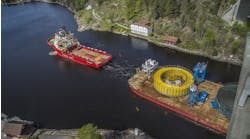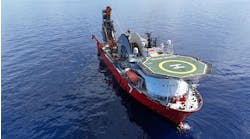The Norwegian Geotechnical Institute (NGI) provides a range of services to the offshore industry, including soil investigations, geohazard evaluation, foundation design, reservoir engin-eering instrumentation and performance monitoring and underwater technology. At its recently opened office in Houston, NGI, an independent private foundation, is handling projects in the Gulf of Mexico, the Caspian Sea, the Sakhalin region, and off West Africa.
As offshore activities move into deeper and less well charted waters, investigating geohazards – earthquake and sea-floor instability risk, the presence of mud volcanoes and gas chimneys, and so on – has become an increasingly important part of the institute's work, says Kjell Hauge, head of personnel and information. NGI is conducting geohazard evaluations for Shell's Bonga project off Nigeria and, under contract to Technip, for BP's Shah Deniz development in the Caspian Sea, where the work scope also includes platform foundation design.
One of the institute's biggest projects was geohazard evaluation for Norsk Hydro's Ormen Lange development in the Norwegian Sea. Investigation of the seabed stability at Ormen Lange, which lies in the area of the Storegga slide of 8,000 years ago, began in 1999. The project occupied 15 of NGI's staff of 145 and extensive laboratory resources. The institute's report, delivered in February, concluded that the prehistoric slide was probably triggered by an earthquake, but that seabed stability is now sufficient to allow development to proceed.
In 2002 NGI was awarded the International Center for Geohazards, one of a series of centers of excellence funded by the Research Council of Norway. The center will provide both research and graduate educational facilities.
The institute's work on foundations for offshore structures dates back to the early days of the North Sea industry. It was at the forefront of the development of skirted foundations and participated in such landmark projects as the Gullfaks C platform, which has skirts 21 m high, and Troll A, with 36 m skirts.
In the early 1990s, it helped to develop the suction anchor that has become a leading option for mooring floating structures, especially in deep waters. A recent reference in this respect is the Diana Spar platform, which is anchored by suction piles – NGI designed the anchors and performed the installation with the instrumented installation jack. For BP's Mad Dog project in 1,200-m depth in the GoM it is now studying the feasibility of using suction anchors to moor the floating platform in 1,200-m depth to a seabed of soft clay located in an old seabed slide area. It is also performing a study of the penetration of suction anchors in soft clay for Total's Dalia project off Angola.
In addition to verifying installation operations, NGI develops instrumentation systems to monitor the stability of platforms once installed, and has provided such systems for many of the structures for which it performed the foundation engineering.


